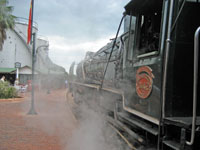
THERE are a number of things that you should do before you die. One of them is to visit a bygone era and experience a journey which can be savoured, rather than merely endured.
A journey on Rovos Rail from Pretoria to Cape Town taking in the gaunt desert scrub of the Karoo, witnessing an African thunderstorm and seeing history in Matjiestfontein is the journey we took to celebrate our 15th wedding anniversary.
Rovos Rail was established in South Africa in 1989 by Rowan Vos who to this day delivers informal briefings to guests about to embark on one of his luxury train journeys. The routes range from a two day trip between Pretoria and Cape Town to a 14 day adventure to Dar es Salaam.
We were met at OR Tambo International in Johannesburg by Rovos Rail transport and delivered to Capital Park Station in Pretoria, a 45 minute drive from Johannesburg.
Arriving at the station is like walking into a time warp – the beautifully renovated and maintained station, formerly a South African Railways maintenance depot, sets the scene. Guests are welcomed by friendly, professional staff serving sandwiches and champagne. There’s memorabilia inside to gape at, and the great steam locomotive idling outside is a sight to behold. Serious ferroequinologists can sit in the engineer’s cab and blow the whistle, like I did.
Each carriage is assigned a number of hosts, who attend guests 24 hours a day. The impeccably restored carriages have three suite options - royal, deluxe and pullman. Our 11 sq m deluxe suite featured a large double bed, living area and bathroom with shower. The royal suite is bigger at 16 sq m, while the pullman suite has a daytime sofa couch which converts to a bed at night.
There is a fully stocked bar fridge, a telephone to summon the hosts, air conditioning and – fortunately – no television and no mobile phones outside the suites.
Once clear of the station, the train stopped and the steam locomotive was swopped for a more environmentally friendly electric version. Then off we went again, clicketty clack through the outskirts of Pretoria and on to Cape Town at a steady 60 kilometres an hour.
In the observation car at the rear of the train there’s an open air section where we could sip cocktails, shoot the breeze with other like-minded fellow guests and watch the scenery unfold. Our train had 17 coaches, which contained 27 suites hosting 52 passengers.
A dinner gong sounds at eight, and guests are expected to dress for the occasion, adding to the romantic ambience of the dining cars - beautifully restored pieces of art, wood, original fittings and comfortable intimate seating.
Dinner included smoked ostrich carpaccio with tempura vegetables, carrot and ginger soup, Springbok loin medallions with a ginger and prune sauce followed by dark chocolate sponge Africana with chocolate sauce.
You do sleep well, lulled by gentle rocking and train sounds. The train is halted each night for about four hours, reinforcing the lack of haste associated with luxury train travel. The good news about these nightly stops is that they can be reduced to enable the train to make up for lost time if there are any delays – most likely in the form of no electricity – a not too uncommon occurrence in South Africa these days.
We took in the town of Kimberley situated in the magnificent Karoo and toured the city, The Big Hole and the Mine Museum. Our train then took us through the path of an African afternoon thunderstorm - the driving rain, thunder and lightning provided an awesome spectacle.
On the second morning, the train stopped in Matjiestfontein where we strolled through the historic settlement and visited the station museum and a collection of antique cars and railway carriages.
From there the track wound through the scenic Hex River Mountains, passing through many tunnels, the longest of which measures over thirteen kilometres. Lunch is served passing through the spectacular Hex River Valley and the town of Worcester.
The train arrived at Platform 24 at Cape Town Station, promptly on schedule at 6 pm, after a 48 hour journey of 1,595 kilometres.
It was a melancholy parting company with our new friends. Train travel is good for the soul; it allows time for reflection, making new friends, rediscovering old ones and briefly returning to an era when travelling was less hurried.
Some of our fellow passengers had travelled on Rovos before, and a number were planning on doing so again. Although it is something you need to enjoy before you die, there is no reason to do it only once. I know we intend to do it all over again, soon.
by Mike Pfeifer
